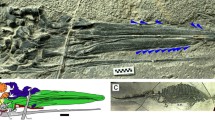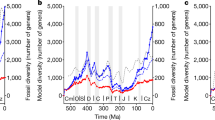Abstract
Our current knowledge on the origin and early evolution of large predators is summarized by Simon Conway Morris (1999, 153–154) as follows:
...for many years it was claimed that Cambrian marine communities were almost entirely free of predators… the seas were [thought to be] full of suspension-feeders gently swaying in the sea water and deposit feeders calmly digging their way through the sediment. This view is now seen to be far too idyllic, but the story of the rise of predators is still quite tentative. It does appear, however, that in contrast to Cambrian communities those of the Ediacaran were largely free of predators.
Access this chapter
Tax calculation will be finalised at checkout
Purchases are for personal use only
Preview
Unable to display preview. Download preview PDF.
Similar content being viewed by others
References
Alexander, R. R., 1987, Intraspecific selective survival within variably uniplicate Late Devonian brachiopods, Lethaia 20:315–325.
Alpert, S., 1976, Trilobite and star-like trace fossils from the White-Inyo Mountains, California, J. Paleontol. 49:661–669.
Alpert, S., and Moore, J. N., 1975, Lower Cambrian trace fossil evidence for predation on trilobites, Lethaia 8:223–230.
Alroy, J., 2001, A multispecies overkill simulation of the end Pleistocene megafaunal mass extinction, Science 292:1893–1896.
Anderson, A., 1989, Mechanics of overkill in the extinction of New Zealand moas, J. Archaeol. Sci. 16:137–151.
Bambach, R. K., and Kowalewski, M., 1999, Diversity of predators compared to the records of prey-predator escalation—two tales of the history of predation, Geol. Soc. Am. Abstr. Progr. 31:336.
Bengtson, S., 1994, The advent of animal skeletons, in: Early Life on Earth (S. Bengtson, ed.), Columbia University Press, New York, pp. 412–425.
Bengtson, S., and Yue Zhao, 1992, Predatorial borings in Late Precambrian mineralized exoskeletons, Science 257:367–369.
Bergson, H., 1908, L’Evolution créatrice, Librairies Félix Alcan et Guillaumin Réunies, Paris.
Birkenmajer, K., 1977, Trace fossil evidence for predation on trilobites from Lower Cambrian of South Spitsbergen, Norsk Polarinstitut Arsbok 1976:187–195.
Blake, D. B., and Guensburg, T. E., 1992, Caught in the act; a Late Ordovician asteroid and its pelecypod prey, Geol. Soc. Am. Abstr. Progr. 24:6.
Bond, A. B., and Kamil, A. C., 2002, Visual predators select for crypticity and polymorphism in virtual prey, Nature 415:609–613.
Bownng, S. A., Grotzinger, J. P., Isachsen, C. E., Knoll, A. H., Pelechaty, S. M., and Kolosov, P., 1993, Calibrating rates of Early Cambrian evolution, Science 261:1293–1298.
Brasier, M., Green, O., and Shields, G., 1997, Ediacaran sponge spicule clusters from southwestern Mongolia and the origins of the Cambrian fauna, Geology 25:303–306.
Briggs, D. E. G., 1994, Giant predators from the Cambrian, Science 264:1283–1284.
Briggs, D. E. G, and Whittington, H. B, 1985, Terror of the trilobites. Nat. Hist. 94:34–39.
Burzin, M., 1999, A mysterious world of Ediacaran organisms, Science in Russia 2:22–28.
Burzin, M. B., and Gnilovskaya, M. B., 1999, Kakimi byli drevneishie zhibotnye, Priroda 11:31–41.
Chen J., Ramsköld, L., and Gui-Qing, Z., 1994, Evidence for monophyly and arthropod affinity of Cambrian giant predators, Science 264:1304–1308.
Collins, D., 1996, The “evolution” of Anomalocaris and its classification in the arthropod class Dinocarida (nov.) and order Radiodonta (nov.), J. Paleontol. 70:280–293.
Conway Morris, S., 1985, Cambrian enigma, Nature 316:677.
Conway Morris, S., 1999, The Crucible of Creation, Oxford University Press, Oxford.
Conway Morris, S., and Bengtson, S., 1994, Cambrian predators; possible evidence from boreholes, J. Paleontol. 68:1–23.
Conway Morris, S., and Jenkins, R. J. F., 1985, Healed injuries in Early Cambrian trilobites from South Australia, Alcheringa 9:167–177.
Culver, S. J., 1991, Early Cambrian foraminifera from West Africa, Science 254:689–691.
Debrenne, F., and Zhuravlev, A. Yu., 1997, Cambrian food web: A brief review, Geobios 20:181–188.
Droser, M. L., Jensen, S., and Gehling, J. G., 1998, The first grave robbers: Early Cambrian ichnofabric, Geol. Soc. Am. Abstr. Progr. 30:233.
Eisner, T., Eisner, M., and Deyrup, M., 1996, Millipede defense: use of detachable bristles to entangle ants, Proc. Nat. Acad. Sci. USA 93:10848–10851.
Evans, J. W., 1910, The sudden appearance of the Cambrian fauna, 11th Inter. Geol. Congr., Stockholm, 1910, Compte Rendu 1:543–546.
Fortin, M.-J., 1994, Edge detection algorithms for two-dimensional ecological data, Ecology 75:956–965.
Gaudry, A., 1883, Les Enchainements du Monde Animal Dans Les Temps Geologiques, Fossiles primaires, Libraire F. Savy, Paris.
Hallam, A., 1992, Great Geological Controversies, Oxford University Press, Oxford.
Hawksworth, D. L., 1994, Strategies for living together, Nature 371:570.
Horny, R. J., 1997, Shell breakage and repair in Sinuitopsis neglecta (Mollusca, Tergomya) from the Middle Ordovician of Bohemia, Casopis Narodniho Muzea v Praze. Rada Prirodovedna 166:137–142.
Jensen, S., 1990, Predation by early Cambrian trilobites on infaunal worms—evidence from the Swedish Mickwitzia Sandstone, Lethaia 23:29–42.
Jensen, S., Gehling, J. G., and Droser, M. L., 1998, Ediacara-type fossils in Cambrian sediments, Nature 393:567–569.
Kelly-Borges, M., 1995, Sponges out of their depth, Nature 373:284.
Khakhina, L. N., 1992, Concepts of Symbiogenesis, Yale University Press, New Haven.
Landing, E., Bowring, S. A., Davidek, K. L., Westrop, S. R., Geyer, G., and Heldmaier, W., 1998, Duration of the Early Cambrian: U-Pb ages of volcanic ashes from Avalon and Gondwana, Can. J. Earth Sci. 35:329–338.
Leighton, L. R., 1999, Antipredatory function of brachiopod ornament, Geol. Soc. Am. Abstr. Progr. 31:43.
Leighton, L. R., 2001, New example of Devonian predatory boreholes and the influence of brachiopod spines on predator success, Palaeogeogr. Palaeoclim. Palaeoecol. 165:53–69.
Lescinsky, H. L., and Benninger, L., 1994, Pseudo-borings and predator traces; artifacts of pressure-dissolution in fossiliferous shales, Palaios 9:599–604.
Margulis, L., and Sagan, D., 2000, What is Life?, University of California Press, Berkeley.
Martin, P. S., 1967, Pleistocene overkill, Nat. Hist. 76:32–38.
May, R. M., 1976, Simple mathematical models with very complicated dynamics, Nature 261:459–467.
McCarty, G., 1976, Calculator calculus, Page-Finklin Publishing Company, Palo Alto, California.
McIlroy, D., and Szaniawski, H., 2000, A Lower Cambrian protoconodont apparatus from the Placentian of southeastern Newfoundland, Lethaia 33:95–102.
McMenamin, M. A. S., 1986, The Garden of Ediacara, Palaios 1:178–182.
McMenamin, M. A. S., 1987, The fate of the Ediacaran fauna, the nature of conulariids, and the basal Paleozoic predator revolution, Geol. Soc. Am. Abstr. Progr. 19:29.
McMenamin, M. A. S., 1988, Paleoecological feedback and the Vendian-Cambrian transition, Trends Ecol. Evol. 3:205–208.
McMenamin, M. A. S., 1992a., The Cambrian transition as a time-transgressive ecotone, Geol. Soc. Am. Abstr. Progr. 24:62.
McMenamin, M. A. S., 1992b, Two new species of the Cambrian genus Mickwitzia, J. Paleontol. 66:173–182.
McMenamin, M. A. S., 1993, Osmotrophy in fossil protoctists and early animals, Invert. Reprod. Develop. 22:301–304.
McMenamin, M. A. S., 1996, Ediacaran biota from Sonora, Mexico, Proc. Nat. Acad. Sci. USA 93:4990–4993.
McMenamin, M. A. S., 1998, The Garden of Ediacara, Columbia University Press, New York.
McMenamin, M. A. S., ed., 2001, Paleontology Sonora: Lipalian and Cambrian, Meanma Press, South Hadley, Massachusetts.
McMenamin, M. A. S., and McMenamin, D. L. S., 1990, The Emergence of Animals, Columbia University Press, New York.
McMenamin, M. A. S., and Whiteside, J. H., 1999, Hypermarine upwelling and a new Vernadskian metric, J. Biosph. Sci. 1,http://www.mtholyoke.edu
Moody, K. E., 2001, Patterns of Predation on juvenile blue crabs in lower Chesapeake Bay: size, habitat and seasonality, in: Proceedings of the Blue Crab Mortality Symposium (V. Guillory, H. Perry, and S. Vanderkooy, eds.), Gulf States Mar. Fish. Commis. Pub. No. 90, Ocean Springs, Mississippi, pp. 84–92.
Moody, K. E., and Steneck, R. S., 1993, Mechanisms of predation among large decapod crustaceans of the Gulf of Maine Coast: functional vs. phylogenetic patterns, J. Exper. Mar. Biol. Ecol. 168:111–124.
Nedin, C., 1999, Anomalocaris predation on nonmineralized and mineralized trilobites, Geology 27:987–990.
Nesis, K. N., 1995, Khishchniki na zare zhizni, Priroda 8:60–62
O’Shea, D., 1980, An Exposition of Catastrophe Theory and its Applications to Phase Transitions, Queen’s Papers in Pure and Applied Mathematics Number 47, Queen’s University, Kingston, Ontario.
O’Shea, D., 1986, Elementary catastrophes, phase transitions and singularities, Math. Model. 7:397–411.
Pickerill, R. K., and Blissett, D., 1999, A predatory Rusophycus burrow from the Cambrian of southern New Brunswick, eastern Canada, Atlantic Geol. 35:179–183.
Schlichter, D., and Fricke, H. W., 1991, Mechanisms of amplification of photosynthetically active radiation in the symbiotic deep-water coral Leptoseris fragilis, Hydrobiologia 216/217:389–394.
Sebens, K. P., and Koehl, M. A. R., 1984, Predation on zooplankton by the benthic anthozoans Alcyonium siderium (Alcyonacea) and Metridium senile (Actiniaria) in the New England subtidal, Mar. Biol. 81:255–271.
Sepkoski, J. J., 1992, Proterozoic-Early Cambrian diversification of metazoans and metaphytes, in: The Proterozoic Biosphere (J. W. Schopf and C. Klein, eds.), Cambridge University Press, Cambridge, pp. 553–561.
Stanley, S. M., 1973, An ecological theory for the sudden origin of multicellular life in the late Precambrian, Proc. Nat. Acad. Sci. USA 70:1486–1489.
Vacelet, J., and Boury-Esnault, N., 1995, Carnivorous sponges, Nature 373:333–335.
Valentine, J. W., 1994, The Cambrian explosion, in: Early Life on Earth (S. Bengtson, ed.), Columbia University Press, New York, pp. 401–411.
Verhulst, P. F., 1838, Notice sur la loi que la population suit dans son accroissement, Coresp. Math. Phys. 10:113–121.
Vermeij, G. J., 1987, Evolution and Escalation: An Ecological History of Life, Princeton University Press, Princeton, New Jersey.
Vernadsky, V. I., 1998, The Biosphere, Springer-Verlag, New York.
Vorwald, G. R., 1982, Healed injuries in trilobites; evidence for a large Cambrian predator, Geol. Soc. Am. Abstr. Progr. 14:639.
Waggoner, B. M., 2000, Rewriting the rulebook; community ecology through the Neoproterozoic-Cambrian transition, Geol. Soc. Am. Abstr. Progr. 32:41.
Walker, T. D., 1985, Diversification functions and the rate of taxonomic evolution, in: Phanerozoic Diversity Patterns (J. W. Valentine, ed.), Princeton University Press, Princeton, New Jersey, pp. 311–334.
Whittington, H. B., 1985, The Burgess Shale, Yale University Press, New Haven.
Whittington, H. B., and Briggs, D. E. G., 1985, The largest Cambrian animal, Anomalocaris, Burgess Shale, British Columbia, Trans. R. Soc. London, Series B, Biol. Sci. 309:569–609.
Author information
Authors and Affiliations
Editor information
Editors and Affiliations
Rights and permissions
Copyright information
© 2003 Springer Science+Business Media New York
About this chapter
Cite this chapter
Mcmenamin, M.A.S. (2003). Origin and Early Evolution of Predators. In: Kelley, P.H., Kowalewski, M., Hansen, T.A. (eds) Predator—Prey Interactions in the Fossil Record. Topics in Geobiology, vol 20. Springer, Boston, MA. https://doi.org/10.1007/978-1-4615-0161-9_17
Download citation
DOI: https://doi.org/10.1007/978-1-4615-0161-9_17
Publisher Name: Springer, Boston, MA
Print ISBN: 978-1-4613-4947-1
Online ISBN: 978-1-4615-0161-9
eBook Packages: Springer Book Archive




